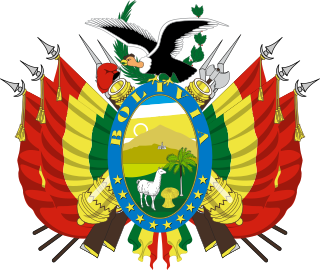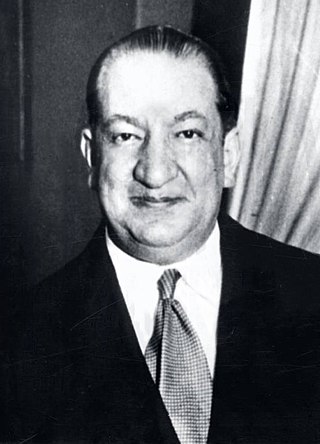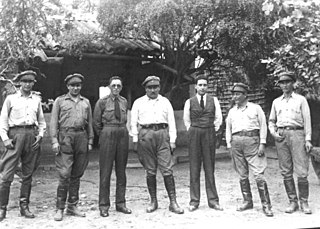| |||||
| Decades: | |||||
|---|---|---|---|---|---|
| See also: | Other events of 1869 History of Bolivia • Years | ||||
Events in the year 1869 in Bolivia .
| |||||
| Decades: | |||||
|---|---|---|---|---|---|
| See also: | Other events of 1869 History of Bolivia • Years | ||||
Events in the year 1869 in Bolivia .
| | This section is empty. You can help by adding to it. (July 2014) |
| | This section is empty. You can help by adding to it. (February 2024) |

Daniel Domingo Salamanca Urey was a Bolivian politician who served as the 33rd president of Bolivia from 1931 to 1934 until he was overthrown in a coup d'état on November 27, 1934, during the country's disastrous Chaco War with Paraguay. Bolivian historians have referred to him as "El Hombre Símbolo", as a president who carefully cultivated an appearance of integrity and nationalism.

José Luis Tejada Sorzano was a Bolivian lawyer, economist, and politician who served as the 34th president of Bolivia from 1934 to 1936. The last president to be a member of the Liberal Party, Tejada Sorzano previously served as the 23rd vice president of Bolivia from 1931 to 1934.

Hernando Siles Reyes was a Bolivian politician who served as the 31st president of Bolivia from 1926 to 1930. The founder of the Nationalist Party, he soon gravitated toward the Saavedrista faction of the Republican Party, which had come to power in 1920. Chosen by President Saavedra to be his successor in 1926, Siles ran on a ticket that included the latter's brother, Abdon Saavedra, as his vice-presidential running mate. This formula won the elections, and Siles Reyes was sworn in August, 1926. Soon, he came to be regarded as one of the most charismatic Bolivian politicians in recent memory, especially when he broke openly with the domineering ex-President Bautista Saavedra, and exiled him along with his brother. Despite all this, the Siles government soon ran into economic and political difficulties associated with the far-reaching effects of the "crash" of 1929. Moreover, his term was marked by rising diplomatic tensions with neighboring Paraguay which would later lead to the Chaco War. Many more opponents were exiled, giving Siles some breathing room, but matters reached a breaking point when, in 1930, the President attempted to unilaterally increase his term in office, ostensibly to deal with the mounting economic and international crisis. This was all his opponents needed, and with a coup d'état clearly in the offing, Siles resigned on May 28, 1930, leaving his cabinet in charge. The latter was overthrown by General Carlos Blanco, who in 1931 called elections which were won by Daniel Salamanca of the Partido Republicano-Genuino. Siles lived the rest of his life in exile, dying in Lima in 1942 at the age of 60.

Carlos Blanco Galindo was a Bolivian general who served as the 32nd president of Bolivia on a de facto interim basis from 1930 to 1931.

Carlos Quintanilla Quiroga was a Bolivian general who served as the 37th president of Bolivia on a provisional basis from 1939 to 1940. Quintanilla saw action in the initial stages of the Chaco War (1932–1935) and managed to ascend the echelon of the Bolivian armed forces until he became commander of the army during the administration of Germán Busch. When President Busch committed suicide on 23 August 1939, Quintanilla declared himself Provisional President of the Republic.

Enrique Peñaranda del Castillo was a Bolivian general who served as the 38th president of Bolivia from 1940 until his overthrow in 1943. He previously served as commander-in-chief of the country's armed forces during the second half of the Chaco War (1932–1935).
Salamanca is a city in Spain.
Bolivia's defeat by Paraguay in the Chaco War of 1932–1936 marked a turning point in the modern history of Bolivia. Significant loss of life and territory discredited the traditional ruling classes, while service in the army produced stirrings of political awareness among the indigenous people. Many of the contested Gran Chaco region was surrendered to Paraguay. In return, Bolivia was given access to the Paraguay River where Puerto Busch was founded, and, with this, free access to the Atlantic Ocean through international waters was possible. In 1936, Standard Oil's Bolivian operations were nationalized, and the state-owned firm Yacimientos Petroliferos Fiscales Bolivianos (YPFB) was created. From the end of the Chaco War until the 1952 Bolivian National Revolution, the emergence of contending ideologies and the demands of new groups convulsed Bolivian politics.

General elections were held in Bolivia on 4 January 1931, electing both a new President of the Republic and a new National Congress. Held in the aftermath of the 1930 Bolivian coup d'état, only the Salamanca-Tejada ticket was allowed to run by the military junta then in power.

Parliamentary elections were held in Bolivia in December 1920 to elect a new National Congress. They followed the coup d'état that prevented the Congress elected in May 1920 from taking office.
The Republican Party was a Bolivian political party founded in 1914.
The Genuine Republican Party was founded in Bolivia in 1921 by José María Escalier and Daniel Domingo Salamanca Urey following a split in the Republican Party.
Events in the year 1933 in Bolivia.
The following lists events that happened during 1932 in the Republic of Bolivia.
Events in the year 1935 in Bolivia.
1920 Bolivian coup d'état was a bloodless takeover of power in Bolivia by the Republican party on July 12, 1920 which overthrew the previously ruling government of the Liberal Party and brought Bautista Saavedra to power as President from 1920 until 1925.

Sara Ugarte de Salamanca (1866-1925) was a Bolivian poet and wife of Daniel Salamanca Urey. She was from Cochabamba. She campaigned to have a monument built to the local heroines who had fought trained soldiers in 1812.

The Cabinet of José Luis Tejada Sorzano was composed of three cabinets which constituted the 94th–96th national cabinets of the Republic of Bolivia. It was led by President José Luis Tejada Sorzano, a Liberal, and was in office from 29 November 1934 to 17 May 1936.

The 1934 Bolivian coup d'état, colloquially known as the Corralito of Villamontes, was a military coup in Bolivia that deposed President Daniel Salamanca in the midst of the Chaco War. Two days before the coup, Salamanca and his presidential delegation arrived at the military headquarters in Villamontes with the intent of removing General Enrique Peñaranda as commander-in-chief of the armed forces and replacing him with General José Leonardo Lanza. In response, on 27 November 1934, army high command directed a group of military officers led by Captain Germán Busch to arrest the president and force his resignation.